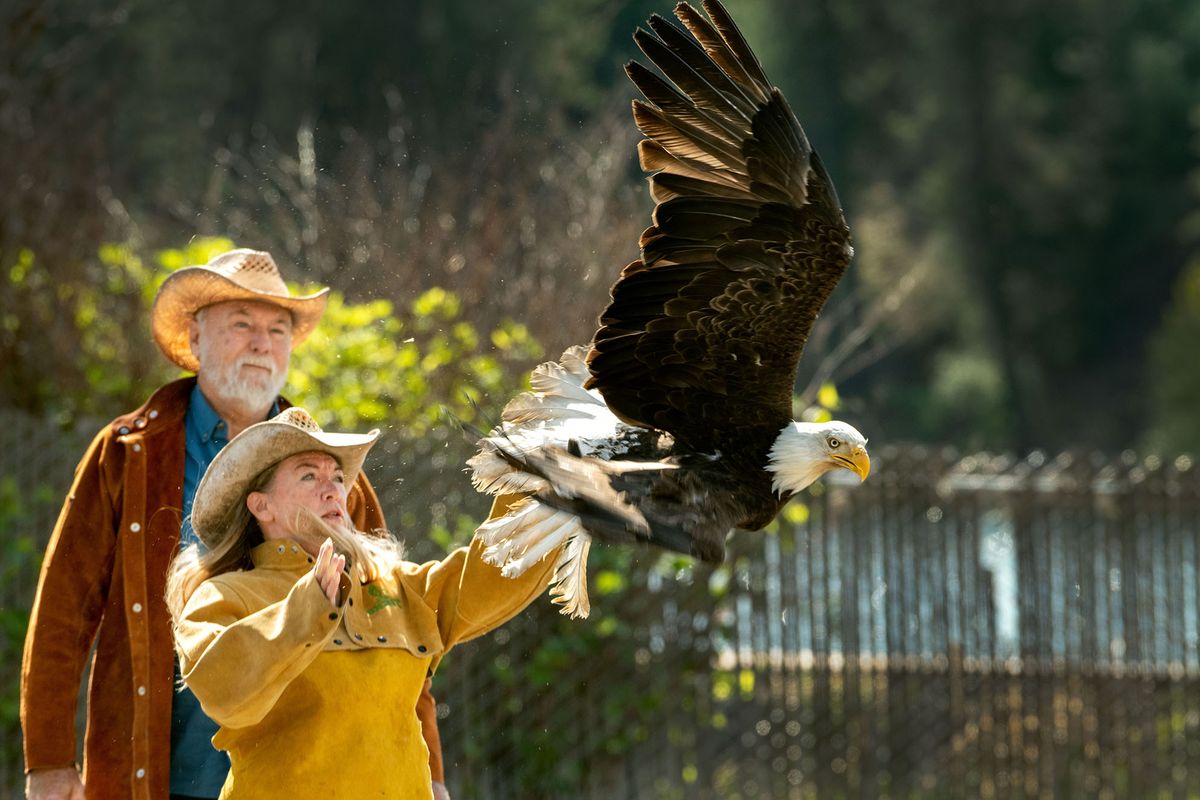Flying free: Bald eagle returns to wild after being poisoned

The paparazzi milled about in the parking lot Tuesday, talking about their big cameras and telephoto lenses, waiting for the celebrity to show.
After a few minutes of suspense, the star was helped out of the van and made his way over to the crowd.
Everyone began adjusting the settings on their cameras. But these paparazzi weren’t preparing to photograph Tom Cruise or Angelina Jolie. They were at Williams Lake, south of Cheney, ready to get an up-close look at a bald eagle.
Birds of Prey Northwest Director Janie Veltkamp carried the big bird tightly against her body so he couldn’t flap wildly. When she was close enough to the lake, she stopped, said a few words to the crowd, and threw the raptor into the air.
Shutters clicked furiously as the eagle unfurled his long wings and took off over the water. Apart from a scuffle with a nearby osprey, the bird’s return to the wild went off without a hitch. The eagle paparazzi – mostly local wildlife photographers – gave him a round of applause.
“It makes you want to cry,” someone in the crowd said.
It was a special opportunity to see an American icon in action at close range. But the eagle release wouldn’t have happened if the bird hadn’t been poisoned and rescued a couple of months ago.
“We have made the place pretty dangerous for flying raptors in the last 100 years,” Veltkamp said.
A dangerous world
The bald eagle is arguably America’s greatest conservation success story.
In the 1960s, there were an estimated 487 nesting pairs of bald eagles left. Widespread use of DDT, an insecticide, poisoned the birds, weakening their eggs’ shells. DDT pushed America’s national symbol to the brink of extinction.
In 1972, the federal government made the controversial decision to ban DDT. Since then, the bald eagle has made a remarkable comeback. It’s one of few species to make it off the Endangered Species List. There are now more than 10,000 nesting pairs.
Bald eagles are a rare conservation success story, but the birds still fly through a gauntlet of human-created hazards.
Eagles can be electrocuted by power lines, illegally shot by hunters, hit by cars and walloped by wind turbines.
This bald eagle suffered from secondary poisoning.
There are a few types of secondary poisoning. The most common is ingestion of lead, which may be left in carcasses that hunters have shot. A fragment the size of a grain of rice can be lethal, Veltkamp said.
Birds of prey can also get sick after eating rodents that have been poisoned with rodenticide.
The symptoms this bird had – slow breathing and heart rates – aren’t indicative of lead or rodenticide poisoning though. Veltkamp said this bird likely ate a euthanized animal.
That might sound bizarre, but Veltkamp said “it happens more than you’d think.”
It’s not uncommon for someone to euthanize an animal and throw the body away at the town dump. Also, if you don’t bury the body deep enough, it can be dug up and become food for wildlife. The barbiturates in the carcass can poison whatever scavengers find the body.
Eagles are mainly scavengers in the winter months, Veltkamp explained.
Apex predators, such as eagles, often serve as important environmental indicators.
“The first to fall ill when we pollute the environment is often the bird of prey sitting atop the food chain,” Veltkamp said.
Most of the time, a raptor that ate a euthanized animal wouldn’t be seen after it got sick. It’d die alone in some remote forest or by some quiet lake.
“This eagle was lucky,” Veltkamp said.
Poisoned by humans, saved by humans
A couple of months ago, Wayne and Judy Albert of Spokane Valley decided to go for a Sunday hike.
They chose the Columbia Plateau Trail, south of Cheney and the Turnbull National Wildlife Refuge. The eagle was along the trail.
“When we saw him, we thought he was dead,” Wayne Albert said. “He was just laying there.”
Thinking the bird was dead, the Alberts left him there and kept hiking. On the return trip, they saw him again, but this time he moved – slightly. They could see him breathing.
They started making some calls. They tried the Spokane County Sheriff’s Office and the Washington Department of Fish and Wildlife. They called veterinarians.
Eventually, they found a vet in Post Falls who passed them along to Veltkamp at Birds of Prey Northwest.
Veltkamp, who has been rescuing raptors for 30 years, said she normally wouldn’t have allowed untrained people to conduct a rescue. It can be unsafe, because raptors have powerful, sharp talons and can injure the people trying to help them.
In this case, with the bird unconscious, Veltkamp wasn’t as concerned about the Alberts getting hurt.
She coached them through the rescue. The Alberts went to a hardware store, bought a crate, a blanket and gloves – to avoid being stabbed.
Since being rescued a few months ago, the bird has been at Birds of Prey Northwest’s facility in St. Maries, recovering.
He’s been fed and given vitamins. The toxins have been flushed from his body, Veltkamp said.
It’s impossible to know if this eagle is a Cheney resident, Veltkamp said. He might spend most of his year in Washington or Idaho or he might be a Canadian or Alaskan bird that flew south for the winter.
Wherever the eagle’s from, Veltkmap said Williams Lake is excellent habitat. Eagles can live up to 20 years, so this male may have a long life ahead of him.
“It’s kind of emotional,” Wayne Albert said Tuesday after watching the bird take off over the water.
“It’s a very good feeling to know that you’ve rescued an animal.”